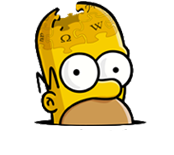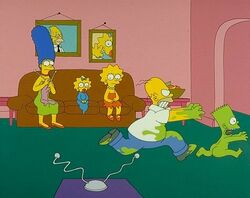
Bart the Genius
|
|||||||||
|
|
|
"Bart the Genius"
| ||
Episode Information
|
- "'"Your son's a genius"'"
- ―J. Loren Pryor
Bart the Genius is the second episode of Season 1 and the first episode of the series to use the famous opening sequence. It marks the first use of Bart's catchphrase "Eat my shorts." The episode aired on January 14, 1990. It was written by Jon Vitti and directed by David Silverman.
Bart swaps papers with Martin Prince at an IQ test. He's referred to the Enriched Learning Center for Gifted Children (proprietor Dr J. Loren Pryor). His new school's laid-back liberal ethos suits him fine - until he's asked to show evidence of his neglected genius.
Plot
As the Simpsons play a game of Scrabble, Lisa reminds Bart that he should be developing verbal abilities for his aptitude test. Later, Principal Skinner catches Bart spraying graffiti on the school. During the intelligence test, Bart imagines himself the literal victim of a difficult math question. Faced with the prospect of flunking the school’s intelligence test, Bart switches exams with brainy Martin Prince. When school psychologist Dr. Pryor studies the results, he is shocked and pleased to learn that Bart is a genius. Upon Dr. Pryor’s suggestion, Homer and Marge agree to place Bart into a school where students learn at their own pace and are unencumbered by grades.
Bart’s first day at his new school leaves him feeling greatly misplaced, as the other students show advanced academic skills. Even though Bart feels out of place at school, he enjoys the newfound attention Homer shows toward him. Marge buys tickets to the opera hoping to stimulate her son with a little culture. But Homer and Bart join forces to ridicule the performance and make rude noises.
Outcast by his genius classmates, Bart visits his old school, but he is rejected by his friends and labeled a “poindexter.” When Bart’s science project blows up and nearly destroys the school, he decides to return to being stupid. Bart confesses to Dr. Pryor that Martin Prince is really a genius and not him. When Bart returns home with his clothes ruined by his science accident, Homer assures the boy that every genius has his bad days. Bart confesses to Homer that he switched tests with a real genius, and although it was a stupid thing to do, he is glad that it at least brought them closer together. An irate Homer chases the boy through the house.
Production
The concept for the episode developed from writer Jon Vitti coming up with a long list of bad things Bart could do and imagining the potential consequences. The only idea that developed into an interesting episode concept was Bart cheating on an IQ test. This idea was based on an incident from Vitti's childhood when a number of his classmates did not take an intelligence test seriously and suffered poor academic treatment because of it. Because Bart was already obviously unintelligent, Vitti reversed the problem for his episode. Vitti used all his memories of elementary school behavior to produce a draft script of 71 pages, substantially above the required length of about 45 pages. It was Vitti's first script for a 30-minute television program. Bart's use of the phrase "Eat my shorts" was intended to reflect his adoption of catchphrases he had heard on TV; the creative team had told Vitti that he should not come up with original taglines for the character. The scene where the family plays Scrabble was inspired by the 1985 cartoon The Big Snit.
Director David Silverman had difficulty devising a legible Scrabble board for the opening scene that would convey the idea that the Simpsons were only able to devise very simple words. The design of Bart's visualization of the math problem was partially inspired by the art of Saul Steinberg. The increasing appearance of numbers in that sequence derived from Silverman's use of a similar tactic when he had to develop a set design for the play The Adding Machine. Each successive scene in the sequence was shorter than the one before it by exactly one frame. The scene where Bart writes his confession was done as one long take to balance the shorter scenes elsewhere in the episode. It was animated in the United States by Dan Haskett. There were a few problems with the finished animation for the episode. The banana in the opening scene was colored incorrectly, as the Korean animators were unfamiliar with the fruit, and the final bathtub scene was particularly problematic, including issues with lip sync. The version in the broadcast episode was the best of several attempts.
The episode was the first to feature the series' full title sequence, including the chalkboard gag and couch gag. Matt Groening developed the lengthy sequence in order to cut down on the animation necessary for each episode, but devised the two gags as compensation for the repeated material each week. Groening, who had not paid much attention to television since his own childhood, was unaware that title sequences of such length were uncommon by that time. As the finished episodes became longer, the production team were reluctant to cut the stories in order to allow for the long title sequence, so shorter versions of it were developed. The episode also introduced the characters Martin Prince and his parents, Richard, Bart's teacher Edna Krabappel and Dr. J Loren Pryor.
Reception & Legacy
In a 1991 interview, Jon Vitti described "Bart the Genius" as his favorite among the episodes he wrote to that point. James L. Brooks also mentioned the episode among his favorites, saying that "we did things with animation when that happened that just opened doors for us." The show received mail from viewers complaining that the throwing away of a comic book was an incident of censorship. Warren Martyn and Adrian Wood, the authors of the book I Can't Believe It's a Bigger and Better Updated Unofficial Simpsons Guide, strongly praised the episode calling it "superbly written and directed, often a literal child's-eye view of education, the first Simpsons episode proper is a classic." They went on to say, "these twenty minutes cemented Bart's position as a cultural icon and a hero to all underachievers, and managed a good few kicks at hothouse schools along the way. Especially worthy of note is the sequence where Bart visualises his maths problem, the viewing of which should be a required part of teacher training." Bart's quote of "Well, you're damned if you do and damned if you don't" has been sampled in the song "Deep, Deep Trouble".
In its original American broadcast, "Bart the Genius" finished 47th place in the weekly ratings for the week of January 8–January 14, 1990 with a Nielsen rating of 12.7. It was the second highest rated show on the Fox Network that week.
The invented word "Kwyjibo" inspired the creator of the Melissa worm.
New Opening Sequence
This episode marked the first time that the opening sequence was used, which was different from the second season opening which would be later introduced in "Bart Gets an F".
- The Simpsons logo is in a darker blue sky with a few clouds.
- The school is white instead of orange.
- The background that is used when Bart is skating out of school is crudely drawn.
- At the power plant, there is a bald man eating a sandwich with tongs.
- The walls of the supermarket are red.
- Maggie's hands are in triangle position.
- Lisa has a much higher-pitched saxophone solo.
- When Homer throws the rod out of the car, it bounces near Moe's Tavern.
- When Bart is skating through town, he steals a bus sign from a group of waiting people. The people run and chase the bus when it passes by them.
- Marge and Maggie ride home in a red sedan.
- There is a sequence with Lisa riding home on her bike with a stack of books and her saxophone. (This was later replaced with the whip across the Springfield citizens.) Also, Lisa gets home first, so Homer only has to dodge Marge after getting out of the car.
- The TV is brown with a dark blue screen.
External Links
- "Bart the Genius" at The Simpsons.com
 "Bart the Genius" at the The Simpsons Archive
"Bart the Genius" at the The Simpsons Archive

